Main Directorate of State Security
The Main Directorate of State Security (Russian: Glavnoe upravlenie gosudarstvennoy bezopasnosti, Главное управление государственной безопасности, ГУГБ, GUGB) was the name of the Soviet most important security body within People's Commissariate of Internal Affairs (NKVD) USSR. At the time of its existence witch was from July 10 1934 to February 3 1941. GUGB reflected exactly the Secret Operational Directorate within OGPU under Council of People's Commissars [1] , which operated within OGPU structure from 1923 to 1931/32. intelligence service and secret police from July 1934 to February 1941. It was run under the auspices of the Peoples Commissariat of Internal Affairs (NKVD). Its first head was first deputy of People's Commissar of Internal Affairs (then - Genrikh Yagoda), Commissar 1st rank of State Security Yakov Agranov.
History
The Main Directorate of State Security evolved from the Joint State Political Directorate (or. OGPU). On February 3, 1941, the Special Sections (or. OO) of the GUGB-NKVD (responsible for counter-intelligence in the military) became part of the Army and Navy (RKKA and RKKF, respectively). The GUGB was removed from the NKVD and renamed People's Commissariat of State Security or NKGB.
Following the outbreak of World War II, the NKVD and NKGB were reunited on July 20, 1941 and counter-intelligence was returned to the NKVD in January 1942. In April 1943 it was again transferred to the Narkomat of Defence and Narkomat of the Navy, becoming SMERSH (from Smert' Shpionam or "Death to Spies"); at the same time, the GUGB was again separated from the NKVD as NKGB.
GUGB heads
By the end of 1937 GUGB was the most powerful and influential organ in NKVD structure. GUGB departments (or Sections) dealt with - intelligence, internal security, counter-intelligence, protection of government and secret communications.
First chief of GUGB was Yakov Agranov, Commissar 1st rank of State Security and first deputy of People's Commissar of Internal Affairs. Next chief of GUGB from April 15, 1937 to September 8, 1938 was komkor Mikhail Frinovsky, he was succeeded by Lavrenty Beria, then just promoted to Commissar 1st rank of State Security. When Beria become People's Commissar of Internal Affairs (head of NKVD), Commissar 3rd rank of State Security Vsevolod Merkulov become his first deputy and new and last head of GUGB.
Organization
Between 1934 and 1941, Main Directorate of State Security went through several organizational changes. In January 1935 in GUGB structure there were nine departments:
- (head of GUGB) – Commissar 1st rank of State Security Yakov Agranov
- Operational Department – Karl Pauker (headed by)
- Special Department – Gleb Bokii
- Department of Economics – (ЭКО/EKO) – Lev Mironov
- Special Department – (OO) – Mark Gay
- Secret Political Department – (СПО/SPO) – Georgy Molchanov
- Foreign Department – (ИНО/INO) – Artur Artuzov
- Department of Transport – (ТО) – Vladimir Kichkin
- Department of Information and Statistic – (УСО/USO) – Yakov Genkin
- Staff Department – (OK) – Yakov Weynschtok
By the end of 1937 People's Commissar of Internal Affairs Nikolai Yezhov, in his order #00362 had change the departments number from nine to twelve.
- (head of GUGB) – komkor Mikhail Frinovsky
- Department 1 [Protection of Government] – Israel Dagin
- Department 2 [Operative] – Ans Zalpeter
- Department 3 [counter-intelligence] (КРО/KRO) – Aleksandr Minayev-Cikanovich
- Department 4 [Secret Political] (СПО/SPO) – Mikhail Litvin
- Department 5 [Special] (OO) – Nikolai Nikolaev-Zhuryd
- Department 6 [Transport] (TO) – Mikhail Volkov
- Department 7 [Foreign (Intelligence)] (ИНО/INO) – Abram Slutsky
- Department 8 [Records and Statistic] (УСО/USO) – Vladimir Cesarsky
- Department 9 [Special (codes)] (OO) – Isaak Shapiro
- Department 10 [Prison] – Yakov Weynschtok
- Department 11 [Maritime Transportation] (ВО/WO) – Victor Yrcev
- Department 12 [Technical and Operational] (OOT) – Semyen Zhukovsky
After Lavrenty Beria took over Frinovsky place as a GUGB head, inn 29 of September 1938, GUGB when through another organizational change -
- (head of GUGB) – Commissar 1st rank of State Security Lavrenty Beria
- Department 1 – [Protection of Government] – Israel Dagin
- Department 2 – [Secret Political] – Bogdan Kobulov
- Department 3 – [counter-intelligence] – Nikolai Nikolaev-Zhuryd
- Department 4 – [Special] — Pyotr Fedotov
- Department 5 – [Foreign (Intelligence)] – Zelman Passov
- Department 6 – [Codes] – Alexander Balamutov
- GUGB Investigating Section —
- (head of GUGB) – Commissar 3rd rank of State Security Vsevolod Merkulov[2]
- Department 1 – [Protection of Party and Soviet officials] –
- Department 2 – [Secret Political] –
- Division 1 [trotskists, zinovievists, leftists, rightists, miasnikovtsi, shlyapnikovtsi, banned from the party, foreign missions]
- Division 2 [mensheviks, anarchists, members of SR, bundists, zionists, clerics, provocateurs, gendarmes, counterintelligence agents, punishers, white cossacks, monarchists]
- Division 3 [combating ukrainian, belarusian, ugro-finic national c-i]
- Division 4 [agent studies on a/s political parties, dashnaks, turkic-tatar-monogolic national c-i, gruzmeks, mussavatists, nationalists]
- Division 5 [literati, press, publishing, theatres, cinema, art]
- Division 6 [academies of sciences, science and research institutes, scientific societies]
- Division 7 [discovery and study of c-i formations among studying youth, system of the People's Commissariat of Enlightenment and children of repressed]
- Division 8 [People's Commissariat of Healthcare of USSR and RSFSR and its education institutions]
- Division 9 [People's Commissariat of Justice, Supreme Court, Prosecutor's Office, People's Commissariat of Social Security and their educational institutions]
- Division 10 [combating church and sect c-i]
- Division 11 [physical culture organizations, volunteer societies, clubs, sports publishers]
- Division 12 [Special council, militsiya, fire guard, military commissariats, leadership of the reserves]
- Department 3 – [counter-intelligence] –
- Division 1 [Germany, Hungary]
- Division 2 [Japan, China]
- Division 3 [England]
- Division 4 [France, Italy, Belgium, Switzerland, Spain]
- Division 5 [Romania, Greece, Bulgaria, Yugoslavia]
- Division 6 [Poland]
- Division 7 [Finland, Sweden, Norway, Denmark]
- Division 8 [United States and countries of South America]
- Division 9 [Turkey, Iran, Afghanistan]
- Division 10 [ white movement c-i elements]
- Division 11 [Latvia, Estonia, Lithuania]
- Division 12 [People's Commissariat of Foreign Affairs, embassies and consulates]
- Division 13 [ ECCI, MOPR]
- Division 14 [ Foreign Trade, trade offices]
- Division 15 [ Intourist and VOKS]
- Diplomat security section
- Diplomat security political department
- Divisions 16, 17, 18, 19 Diplomat security
- Department 4 – [Special] —
- Division 1 [headquarters]
- Division 2 [intelligence directorates]
- Division 3 [aviation]
- Division 4 [technical troops]
- Division 5 [motorized detachments]
- Division 6 [artillery, cavalry and artillery detachments]
- Division 7 [infantry, cavalry and artillery detachments]
- Division 8 [ politruk]
- Division 9 [medical service]
- Division 10 [Navy]
- Division 11 [NKVD troops]
- Division 12 [organizational and mobilizing]
- investigative section
- Department 5 – [Foreign (Intelligence)] –
- Division 1 [Germany, Hungary, Denmark]
- Division 2 [Poland]
- Division 3 [France, Belgium, Switzerland, Holland]
- Division 4 [England]
- Division 5 [Italy]
- Division 6 [Spain]
- Division 7 [Romania, Bulgaria, Yugoslavia, Greece]
- Division 8 [Finland, Sweden, Norway, Spitzbergen]
- Division 9 [Latvia, Estonia, Lithuania]
- Division 10 [United States, Canada, South America, Mexico]
- Division 11 [Japan, Manchuria]
- Division 12 [China, Xinjiang]
- Division 12 [Mongolia, Tuva]
- Division 12 [Turkey, Iran, Afghanistan]
- Division 12 [technical intelligence]
- Division 12 [operational equipment]
- Division 12 [visas]
- Department 6 – [Ciphering, safeguard of state secrecy] –
- Division 1, 2, 3 [safeguard of state secrecy, verification and recordkeeping of those admitted to secret work and documents]
- Division 4 [deciphering]
- Division 5 [research, development and recordkeeping of ciphers, drafting NKVD ciphers, preparation of ciphering specialists]
- Division 6 [NKVD encrypting process]
- Division 7 [organizational management of peripherals, development of instructions and regulations on secret ciphering and agent missions]
- Division 8 [ciphering]
- GUGB Investigating Section —
GUGB Ranks
The GUGB had a unique system of ranks, a blend of position-rank system used in the army and personal ranks used in Militsiya; the rank insignia was also very distinct. Even though insignia introduced in 1937 followed the Red Army collar patch patterns, it assigned them very different ranks for GUGB and Internal Troops/political/specialist branches, with GUGB rank placed at least one grade higher than a similar army equivalent.[3][4][5][6]
When GUGB and Militsiya ranks were replaced with military ranks and insignia in February 1943, Major to Sergeant ranks were aligned with Colonel to Junior Lieutenant, and Senior Major and up were replaced with various degrees of Commissar. In 1945, General Commissar Lavrentiy Beria received the rank of the Marshal of the Soviet Union, and other GUGB Commissars received the ranks from Generals of the Army to Major General.
- Ranks of GUGB 1935–1943
- генеральный комиссар ГБ – Comissioner General of State Security
- комиссар ГБ 1-го ранга – Commissioner 1st rank of State Security
- комиссар ГБ 2-го ранга – Commissioner 2nd rank of State Security
- комиссар ГБ 3-го ранга – Commissioner 3rd rank of State Security
- старший майор ГБ – Senior Major of State Security
- майор ГБ – Major of State Security
- капитан ГБ – Captain of State Security
- старший лейтенант ГБ – Senior Lieutenant of State Security
- лейтенант ГБ – Lieutenant of State Security
- младший лейтенант ГБ – Junior Lieutenant of State Security
- сержант ГБ – Sergeant of State Security
- Rank insignia 1935-1937
| Commissioner General of State Security | Commissioner of State Security 1st Rank | Commissioner of State Security 2nd Rank | Commissioner of State Security 3rd Rank | Senior Major of State Security | Major of State Security | Captain of State Security | Senior Lieutenant of State Security | Lieutenant of State Security | Junior Lieutenant of State Security | Sergeant of State Security |
|---|---|---|---|---|---|---|---|---|---|---|
 |
 |
 |
 |
 |
 |
 |
 |
 |
 |
 |
 |
 |
 |
 |
 |
 |
 |
 |
 |
 |
 |
| Source: [7] |
- Rank insignia 1937-1943
| Commissioner General of State Security | Commissioner of State Security 1st Rank | Commissioner of State Security 2nd Rank | Commissioner of State Security 3rd Rank | Senior Major of State Security | Major of State Security | |||||
|---|---|---|---|---|---|---|---|---|---|---|
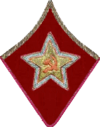 |
 |
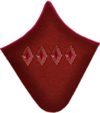 |
 |
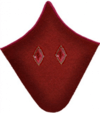 |
 | |||||
| Source: [8] | ||||||||||
| Captain of State Security | Senior Lieutenant of State Security | Lieutenant of State Security | Junior Lieutenant of State Security | Sergeant of State Security | |||||
|---|---|---|---|---|---|---|---|---|---|
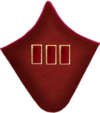 |
 |
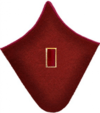 |
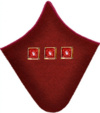 |
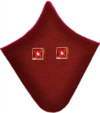 | |||||
| Source: [8] | |||||||||
See also
References
- ↑ {{subst:saved_book}}
- ↑ Structure and functions of NKVD USSR at the end of 1939 (Структура и функции НКВД СССР на конец 1939 года). Aleksandr Yakovlev Foundation.
- ↑ http://www.rkka.ru/uniform/terms/zvania_nkvd.htm
- ↑ http://www.uniforminsignia.net/?option=com_insigniasearch&Itemid=53&result=1923
- ↑ http://www.uniforminsignia.net/?option=com_insigniasearch&Itemid=53&result=1924
- ↑ http://www.uniforminsignia.net/?option=com_insigniasearch&Itemid=53&result=1925
- ↑ Звания и знаки различия органов госбезопасности (1935 – 1943 г.) Retrieved 2017-08-28.
- 1 2 Форма и знаки различия в органах госбезопасности 1922- 1945 гг. Retrieved 2017-08-28.
- Piotr Kołakowski - NKWD i GRU na ziemiach Polskich 1939-1945 - (Kulisy wywiadu i kontrwywiadu) - Dom Wydawniczy Bellona Warszawa 2002 - (NKVD and GRU on Polish soil 1939-1945 [Intelligence counter-intelligence series] Warsaw, 2002)
